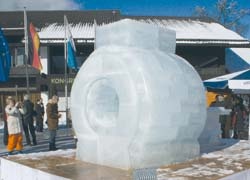Heart, body and mind
In January, at the International MRI Symposium to be held in 13th time, Garmisch-Partenkirchen, it was clear that high-field Magnetic Resonance Imaging (MRI) has established itself as a robust procedure in clinical routine diagnostics. Magnet openings with larger diameters fulfil the increasing demand for patient comfort particularly in the western hemisphere. Apart from 3-Tesla systems a new generation of systems with field strengths of 7-Tesla is within reach, and the first systems are already undergoing clinical testing. Guido Gebhardt reports:
The clear focus of the numerous lectures given at the International MRI Symposium was on cardiac imaging.

Whether tissue phase mapping, perfusion, MR coronary angiographies or late enhancement, the congress leadership under Professor Maximilian Reiser, Director of the Institute for Clinical Radiology at the Hospital of the Ludwig-Maximilian University, Munich and Professor Hedvik Hricak, Chairman of the Department of Radiology at the Memorial Sloan-Kettering Cancer Centre, ensured that the lecturers presented the latest developments in the field.
Developments in molecular biology have also been rapid and are preparing a new paradigm in MRI: Morphological clarification of individual organ systems will soon be complemented by functional, metabolic and molecular characterisation of diseases. In the last few years, molecular imaging approaches have also been introduced for cardiovascular questions, for example in arteriosclerosis research, myocardial vitality diagnostics, heart insufficiency, gene therapy and stem cell transplantation.
Less spectacular, but almost within reach of becoming clinical routine, the continuous development of MR contrast media and MR sequencing technology are leading to an increasing diversification in MR diagnostics and therefore to a diagnostics and therapy control to become more customised to individual illnesses and patients. In this context, the clinical research results for nephrogenic systemic fibrosis (NSF) presented by Thomas Lauenstein were of particular interest, for he delivered concrete advice on the subject of patients suffering kidney insufficiency.
Andrew Webb of the University of Lijden, in the Netherlands, also held keen audience attention, when he reported his research results from a comparison of examinations carried out with the new 7-Tesla systems and with 3-Tesla scanners. Contrary to expectations, the 7-Tesla images did not always deliver better results. In fact, in some cases there was a disadvantage with the new systems. A high spatial resolution and susceptibility ensure lower signal-to-noise ratio and short examination times, but the images are less homogenous and have more artifacts. However, there are significant advantages in the use of the 7-Tesla systems in high resolution MR angiography. Due to the thin layers, the specific absorption rate (SAR) is less problematic. Additionally, the new generation of systems show up neurodegenerative diseases, such as multiple sclerosis or Alzheimer’s disease.
The proven concept of the MR symposium in Garmisch will be further developed and built on in the future. Well-known experts offer radiologists in hospitals and private practice important and useful information for their daily work. The scientists present overview lectures in which they give the audience outlooks over developments that are likely to become important for practical work in the very near future.
The congress leaders would like to enhance the interactive component of the event further. More than in previous years, Professors Reiser and Hricak invited participants to interact through film reading sessions, interactive case demonstrations and tutorials in smaller groups (Meet the expert) and to actively discuss difficult cases and problems. The entire event, basic courses and the scientific programme have been certified by the German Academy for Advanced Training in Radiology and the Bavarian Medical Association.
The next MR congress will be held in Garmisch in January 2011.
A CT symposium will be held in 2010.
01.03.2009











